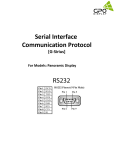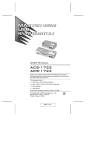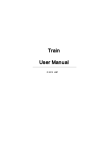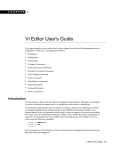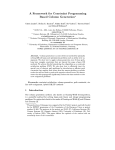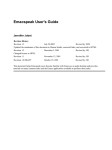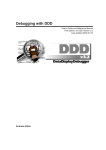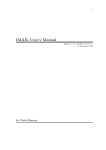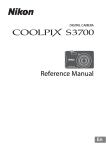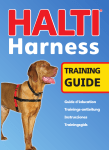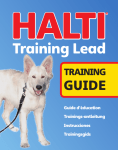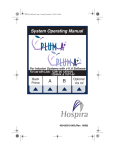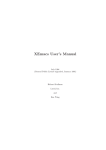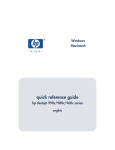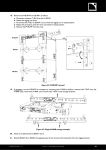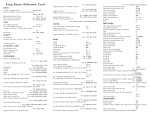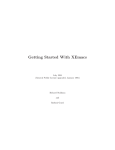Download DON`T PANIC
Transcript
DON'T PANIC by Jason A. Wilson and the Scheme Team An Introductory Guide to the 6.001 Computer System Edition 1.2 December 1997 c 1992, 1998 Massachusetts Institute of Technology Copyright Department of Electrical Engineering and Computer Science. Permission is granted to distribute verbatim copies of this manual provided that the copyright notice and this permission notice are preserved on all copies. Chapter 1: The 6.001 Lab and other Scheme Implementations 1 1 The 6.001 Lab and other Scheme Implementations 1.1 Important Information Please make special note of the following points: Don't Turn O the Lab Computers. The switch is below the yellow ashing light near the oppy disk drive so be careful not to mistake it for the oppy disk eject button. Read The Entire Problem Set BEFORE you begin your work. Often, a question you have will be explained in a later section of the problem set. Browse the 6.001 Web page at least once a week. It contains course handouts, announcements Scheme software, documentation, advice on where to get help, and other useful information. The page is located at http://mit.edu/6.001. Read Chapter 3 [Logging In], page 6, for information about logging in for the rst time in the 6.001 lab. We have put this information here in case you decide not to read this entire guide. Generally, this manual is organized on a \learn-as-you-go" basis. Anything that is not essential to doing a problem set is not explained here; however, we will describe how you can nd additional information on-line. Although this extra information might not be necessary to complete the problem sets, it will make the problem sets easier and so we urge you to explore. 1.2 Scheme Implementations for 6.001 The 6.001 Lab is reserved for the exclusive use of students in 6.001. You'll nd it convenient to work here because the Lab Assistants are available to help you, and you can share the warmth and camaraderie of your classmates while you work on problem sets. If you want to use your own computer, the 6.001 sta provides implementations of Scheme for Linux, Windows NT 4, and Windows 95 (sorry, no Macs). See the course web page for software and installation instructions. The problem sets are designed so that they run on all of these implementations, and you can move your work between them if you nd this useful. For example, you might start problem set at home, then spend some time debugging it in the lab where the Lab Assistants can help you, and then nish things up at home. 6.001 is not supported on Athena. The implementation of Scheme on Athena is not compatible with the 6.001 implementations, and we do not guarantee that it can run all the problem sets (and we do guarantee that cannot run some of the problem sets, e.g., PS2). One way you can use Athena is as a repository for your own working les, and for transferring the les between the 6.001 lab and your personal machine. See the course web page for information on how to do this. (Don't use FTP from the 6.001 lab! See the 6.001 web page for information.) When you work in the lab, you'll normally be storing your les on a oppy disk because there is no permanent storage for students on the 6.001 lab system. The 6.001 sta is also experimenting with ways for you to get help on problem sets without coming having to come to the lab. Again, see the web page for information. Chapter 1: The 6.001 Lab and other Scheme Implementations 2 1.3 Lab Location The 6.001/.004 lab is located in room 34-501. The easiest way to get there is by the elevator in building 36. Since the door outside the lab has an electronic lock, you will want to bring along the combination, which is given out in lecture. Make sure you also bring your textbook, your oppy disks, this guide, and a copy of the problem set. 1.4 Lab Assistants Lab Assistants (LAs) are an integral part of the 6.001 lab. They make sure that everything runs smoothly by maintaining hardware and xing certain problems so that the lab is available to as many students as possible. However, LAs are not in the lab just to maintain hardware; their real purpose is to oer you assistance on problems that you encounter while trying to do the problem sets. If you get stuck, check the blackboard for the help queue status. If the queue is on, write the name of your machine in the next available space. If the queue is o, look for an LA walking around or using a computer to assist you. Don't think that you must have a major problem to ask for help. Although the LAs are not there to write your code for you, they can assist you when you stop making progress on your problem set. The best way to make sure that all of your questions get answered is to get to the lab early in the week. The night before the problems set is due is not a good time to ask an LA to explain a complicated issue. Instead, come to the lab early or make an oce appointment with your recitation instructor or TA if you begin having diculties. The lab will be very busy the night before the problem set. If you notice hardware problems, you should contact one of the LAs on duty. If one is not in the room, place a note by the computer that explains what you think the problem is and when you noticed it. If an extreme problem occurs (like a re) when an LA is not around, contact someone at the equipment desk located outside of the lab. Chapter 2: The Scheme of Things 3 2 The Scheme of Things The 6.001 text book describes how to program in Scheme but it gives none of the details of how these programs are entered into the computer, tested and changed. This chapter describes the basic things that happen when you use the computer. 2.1 Flow of Control Control of the computer begins with you. You can direct the computer by moving the mouse1 or by typing at the keyboard. These keystrokes and mouse actions are rst inspected by a program called the \window manager" to see if you are requesting that it perform some operation. The window manager then passes your keystrokes to the application that has the focus (the highlighted window has the focus). Ordinarily, the only application that you see is Edwin, a text editor very similar to Emacs. You will usually want Edwin to have the focus. You can tell the window manager to give Edwin the focus by clicking the mouse on the border surrounding the Edwin window. This should make the border dark grey and allow Edwin to receive your keystrokes. A text editor is a program that allows you to compose text (programs, memos, letters, books, etc.) much as you would with a typewriter. Unlike a typewriter, Edwin will allow you to modify text that you have already written so that you don't have to type it in all over again. Edwin also allows you to work on more than one piece of text at a time, each in its own buer. Buers are not permanent, however, Edwin lets you save buers in les. If you are working in the lab with a oppy disk, then when you log in Edwin will read all of the les from your oppy disk and place them onto your lab machine's disk so that you can edit them. When you log out, Edwin will automatically checkpoint your oppy disk (store your changes onto the oppy). The les on the computer's hard disk are not permanent and will go away when someone else logs into the machine. To retain these les, Edwin must place them onto your oppy disk. This operation is known as checkpointing. If something goes wrong, talk to an LA who may be able to recover your work from the the hard disk. Whenever you would like to make sure that changes to your les on the hard disk appear on the oppy disk, you may also explicitly request that Edwin do a checkpoint and return to your work. If you are working in the Lab without a oppy disk and keeping your les on Athena, remember to transfer your modied les back to your Athena directory before logging out. Once you have written your programs using Edwin, you can instruct Edwin to send them to the Scheme interpreter and record the results. Although almost any buer can send expressions to the Scheme interpreter, the Scheme interpreter writes its responses only into the `*scheme*' buer. The `*scheme*' buer is the default buer that Edwin displays when you rst log in. 2.2 Special Buers 1 Here is a short list of most of the buers that you will working with: A mouse is a device that controls a small \pointer" (usually shaped like an arrow or an `x') on the screen. Chapter 2: The Scheme of Things 4 `*scheme*' This is the buer where you get responses from the Scheme interpreter. Also, you should evaluate test expressions in this buer. `*transcript*' This buer also gets all the responses from the Scheme interpreter. It diers from the `*scheme*' buer in that you are not meant to type expressions here. Like a \black-box", think of it more as a diary of what has taken place since you have logged in. You copy text out of this buer to make a transcript. You very rarely want to type things into this buer. Problem Set Code Buers These buers contain the code that makes the problem sets do their magic. Normally they are read-only signifying that you should not change them. If it becomes necessary for you to change the code in one of these buers, copy only those parts which you need to change into your answer buer. Answer Code Buers This is where you spend time writing programs. Normally your answer buers end with `.scm' which tells Edwin that the contents of the buer is Scheme code. Usually you only need one answer buer per problem set for code but using additional buers to store partial transcripts and comments to yourself is very useful. You will also want your answer buers to correspond to a le on your oppy disk. To do this, remember to save your changes and then checkpoint your disk or log out (which will automatically checkpoint the disk) or else your work will be lost when you leave the lab. 2.3 Standard Conventions We have already told you enough about communicating with the window manager to get you through 6.001. Obviously, much more will be said about communicating with Edwin and thus the Scheme interpreter. Normally, pressing an alphanumeric key tells Edwin to insert a character in the current buer. However, you can press special keys in combination with normal keys to give Edwin commands. The Control key is located next to the `a' key. It works like the shift key meaning that you should hold it down while pressing another key. For example, when we say C-x we mean: hold down the key labeled hCTRLi while you press `x'. The Meta key also works like the shift key. It is located on either side of the space bar and is labeled hEXTEND CHARi on the lab machines and hALTi on most PC keyboards. When we say M-x, we mean hold down the Meta key while you press `x'. Sometimes it is necessary to hold down both hCTRLi and hEXTEND CHARi at the same time. When we want you to do this, we will say C-M-x. Some commands take immediate eect while others wait for you to type a response to a question posted in the mini-buer. At this point, pressing just one more key will sometimes cause the command to take eect. Otherwise, Edwin expects you to type a few words into the mini-buer and press RET to tell Edwin when you are done. For more information, see Section 4.2.1 [Mini-buer], page 8. Like Meta and Control, there are other keys that we refer to with special abbreviations. Chapter 2: The Scheme of Things TAB RET SPC LFD ESC the tab key the Return key space or the space-bar line-feed or C-j the escape key 5 Chapter 3: Logging In and Loading the Problem Set 6 3 Logging In and Loading the Problem Set 3.1 Logging In Here's how to log in at the 6.001 lab: 1. Place your Primary oppy disk in the disk drive. Your primary disk is the one that you will normally use for storing your 6.001 les. It's a (very) good idea to regularly back up your primary disk to another backup disk. 2. Type u 6 0 0 1 RET at the \Login:" prompt and then type u 6 0 0 1 RET at the \Password:" prompt. 3. Indicate to Edwin that you want to log in normally, by pressing RET or typing L (which is the default).1 4. You are done with the log in. Make sure the Primary disk is in the disk whenever you want to checkpoint it or whenever you want to log out or else all of your new work will be lost. The oppy disks use an MS-DOS le format so you should be able to access your les with a PC, an Athena workstation (using dosread and doswrite), and some Macintoshes (although we don't support the 6.001 Scheme system for Macs or for Athena). Note that this means that all of your les (and buers) must have names that contain only alphabetic and numeric characters. Due to DOS restrictions, the le names may have one period in them and you can put up to 8 characters before the period and three characters after it. 3.2 Loading Problem Sets Type M-x load-problem-set. Edwin prompts you for the problem set number in the mini-buer. Edwin should also show a default problem set in parentheses. To select the default just type RET. Otherwise, enter the correct problem set number and then hit RET. If you are working on your own computer, and starting a new problem set, you'll need to download the problem set les to the correct directory on your own machine. After that, M-x load-problem-set will work as above. You'll nd the weekly problem set les, together with instructions for downloading them, on the course web site. 1 There are other login options for logging in without a disk, and for initializing a disk. The disks you got at the Instrument Room should have been pre-formatted. Reformatting a disk takes about 5 minutes; don't do this unless you really need. And of course, don't reformat a disk that contains les that you need|the les will be destroyed. Chapter 4: Editing Your Code 7 4 Editing Your Code Edwin normally displays the `*scheme*' buer, the mode line, and the mini-buer when it starts up. The mode line tells you useful information like the name of the buer above it and whether that buer is read-only, modied or unmodied. It has the following appearance: --ch-Edwin: buer (major minor )----pos----------The italicized elds have the following meaning: ch is `**' if the text has been modied or `--' if the buer has not been modied since last being saved. A read-only buer contains `%%' in this eld. buer is the name of the buer. major is the major mode of the buer. For example, most buers contain \Scheme" here. minor (an optional eld) is the minor mode of the buer. For example, \Fill" appears when a buer is in auto-fill mode. pos is information about the position of the point in the buer. This eld may be either `All',`Top', `Bot', or a percentage. The `*scheme*' buer and any buer that ends with `.scm' have an additional eld, the run-light, to tell you whether it is currently evaluating a Scheme expression. For example: --**-Edwin: *scheme* (REPL: listen)----ALL----------- means that Edwin is ready to evaluate something. Edwin changes listen to eval when it is busy evaluating an expression. If Edwin has been evaluating for a long time and you would like to stop it, type C-c C-c to interrupt the Scheme interpreter and get back to \listen" status. The mini-buer is the bottom line in the Edwin window. It is used for communicating with Edwin when you request certain commands. For example, when you visit a le, Edwin prompts you for the le's name in the mini-buer. The commands you will use most often will deal with editing your code. We will briey describe those commands in this chapter. 4.1 Loading a File into a Buer In order to modify a le or to create a new one, you must rst instruct Edwin to \visit" the le. Do this by typing C-x C-f le-name. This will cause Edwin to create a new buer and place the contents of the le into it. If the le does not exist, Edwin will make an empty buer and allow you to edit that instead. If you didn't want to start a new le, type C-x k RET to kill the buer and try again. 4.2 Switching Between Buers Once you have a few buers in memory, you will want to switch between them quite often. Typing C-x b buer-name allows you to enter the name of the buer that you would like to switch to. It will also display a default buer that you may select by pressing return. Chapter 4: Editing Your Code 8 C-x C-b switches you to the `*buffer list*' buer. This buer isn't meant for editing text. Instead, you use `*buffer list*' to select buers from a list of all the buers that Edwin knows about. You may use the cursor keys to move to the line of the buer and press `f' to select it. Other commands have a natural side eect of moving you to a new buer. For example C-x k will kill the current buer and then place you into the previous buer. Remember that if you kill a buer without saving it, all of your changes will be lost. Edwin will warn you if you try to kill an unsaved buer, and give you a chance to back out of the command. If you really want to kill the buer without saving your changes, type yes. 4.2.1 The Mini-buer The mini-buer is the last line of the Edwin window where Edwin sometimes expects you to type responses to questions that it asks. There are two things that you should know about the mini-buer. First of all, pressing C-g will exit the mini-buer at any time. Second, pressing hSPCi or hTABi while in the mini-buer will generally cause Edwin to try to complete what you have begun to type. If you have typed a unique prex to a word, then Edwin will complete that word. Otherwise, Edwin will list all of the possible completions to your prex. You may then type just enough characters to give you the command, le, or buer that you really want. This feature of Edwin will save you countless keystrokes. To learn how Edwin can complete Scheme procedure and variable names, see Section B.3 [Scheme Completion], page 22. 4.3 Editing A Buer 4.3.1 What you should and should not edit In general, you should never change the buers that contain read-only code given to you in the problem sets, nor should you change the `*transcript*' buer. If you want to change these buers, you should copy the sections you want into one of your buers rst (see Section 4.3.4 [copying text], page 9). Otherwise, you will end up with tiny changes that no one will be able to nd. This will make your code much more dicult to debug. 4.3.2 Inserting Letters and Moving The Point Once you are in the buer you want to edit, typing characters causes text to be inserted into the buer at the point (the little reverse-video box), but nothing is overwritten. If you would like to delete a character or two use Back space to remove the character to the left of the point and C-d to delete to the right of the point. If you want to delete a whole line, use C-k to erase all the text right of the point on the current line (C-y will bring the text back if you make a mistake). The cursor motion keys (the keys with triangles on them) allow you to move the point to a new location and begin inserting characters there. There are also commands that allow you to move the point around much faster over larger areas. C-v will move the point down an entire screen while M-v will move the point up by the same amount. C-e will move the point to the end of a line while C-a will move it to the beginning. Refer to the on-line documentation for more commands to move the point around. Chapter 4: Editing Your Code 9 4.3.3 Undoing Mistakes If you make a mistake while editing your code, type C-x u. Edwin remembers about 8000 characters worth of changes that it will allow you to undo. Consecutive repetitions of C-x u will cause Edwin to undo older and older changes. Any command other than an undo breaks the sequence. At this point C-x u will allow you to undo your undos, known as redoing an undo. If you really mess up, it is sometimes desirable to restore the buer to the way it was the last time you saved it. You can do this by typing M-x revert-buffer. 4.3.4 Using the Region to Copy or Move Text Many Edwin commands operate on a region of text. First you set up the region and then you type a command to operate on it. You begin the region by setting up what is known as the mark. To do this, move to the beginning of the text that you want to dene as the region and then press C-SPC. Next move the point to where you want the region to end and invoke a command. For example, C-w will delete the region and place it into what is aectionately called the kill ring. You can get this text back by typing C-y. Also, you can type M-w which will place a copy of the text into the kill ring without deleting it. You can also extract this copy with C-y. To nd out where the mark is at any time, press C-x C-x which swaps the point and the mark. Pressing C-x C-x again will swap the point and mark back. 4.4 Saving A Buer You should save your answer buers periodically so that if the computer crashes, you do not lose all your work. This is done by typing C-x C-s. If you are working in the lab with a oppy disk then when you log out, saved les are transferred onto your oppy disk replacing the old versions. Remember that if you log out incorrectly and your les are not checkpointed then you will lose your work when someone else logs into the machine. 4.5 Using Dired to Manage Your Files Generating all these les means that we will need some way to manage them. Edwin provides a command, M-x dired, for showing a visual representation of a directory of les. Dired creates a special buer which you can not edit in the normal way. Instead, you have an easy way to rename les, to mark les for deletion, and to load les into buers for editing. When you are in the Dired buer, typing C-h m will display all of the commands available there. To select a le for editing, move the point to the line of a le and then press `f'. This is like typing C-x C-f le-name. Pressing `o' will do nearly the same thing except that the le will be loaded into another text window and the Dired buer will stay where it is. To delete individual les, move the cursor to the correct line and press `d' and Edwin will place a `D' beside the le. You can unmark the le by pressing `u' when you are on the line. When you have marked all the les that you are sure you want to be deleted, press `x' and answer yes. Now when you checkpoint your disk or when you log out, Edwin will Chapter 4: Editing Your Code 10 remove these les from your oppy drive too. If you accidentally erase a le talk to an LA because sometimes it is possible to recover lost les. To delete backup copies of les with Dired, press `~' and all the backup les will have a D placed beside their names. Now pressing `x' will cause Edwin to ask you if you would like to delete these les. Type yes and then those les will be deleted. Again, the process isn't complete until you checkpoint your disk or log out. Chapter 5: Running and Testing Your Code 11 5 Running and Testing Your Code 5.1 Evaluating Code There are a few ways to evaluate code from a buer. One way is to type M-o. This command tells Edwin to send the entire buer to the Scheme interpreter to be evaluated. M-o is not dened in the `*scheme*' buer. Another command, M-z, tells Edwin to only send the current denition to Scheme in order to be interpreted. A denition in this case is not necessarily an expression such as (define (foobar baz) ...). Instead, Edwin searches backwards until it nds an open parenthesis on the left margin, searches forward to nd its mate and evaluates the expression in between. This makes it convenient for all sorts of \top-level" expressions. A third way to evaluate expressions gives more control than either of the rst two methods. C-x C-e evaluates the expression just before the point regardless of where it is in relation to all the parentheses. Some people try to remember which denitions they have changed so that they only evaluate those portions of their program. This is often more trouble than it is worth because if you forget to update just a single denition, then a bug that you thought you just xed still appears and you could be confused for a long time. If you always use M-o then your code will be up-to-date with what is written when you test it. 5.2 The `*scheme*' buer The most sensible place to test your code is in the `*scheme*' buer. Typing a test case (a Scheme expression meant to test portions of your code) and then M-z or C-x C-e generates a nice listing of trial expressions and their results. If you would like to repeat a test case that you have evaluated already, M-p will allow you to cycle through your most recent expressions. Every time you press M-p, Edwin shows copies of older and older expressions that have been evaluated in the `*scheme*' buer. When this history runs out, Edwin just starts over at the beginning. It is often the case that you would like to repeat the last evaluated expression with dierent arguments. There is a right and a wrong way to do this. The right way is to type M-p, edit the expression, and then type C-x C-e. The wrong way is to use the cursor keys to move up through the Scheme buer and edit the previous expression in its original context. It is much faster and easier to use the history mechanism, and using it won't leave you with a confusing buer, unlike direct editing. 5.3 Debugging When testing your code you will nd that often it doesn't work as expected. Sometimes your code will stop dead in its tracks and produce an error message on the screen, sometimes it will return an incorrect result, and sometimes it won't return anything at all because it is caught in an innite (or at least an unreasonably long) loop. These mistakes in your code are called bugs and getting rid of them is an art-form known as debugging 1. The rst kind of bug is often the easiest to x. Sometimes you have just misspelled a variable or procedure name, or have misplaced a parenthesis. Usually your typos are obvious 1 The Cynic's First Law states that programs don't become more reliable as they are debugged; the bugs just become harder to nd. Chapter 5: Running and Testing Your Code 12 when the computer points them out to you. At other times the computer screams at you when your program is trying to do an illegal operation (like trying to add two procedures!). In cases like this, it is useful to enter the debugger and see what you can learn about the bug. Questions you should ask yourself are: How did my procedure get into this state? Do any variables have values that they clearly should not? Are all the procedures that I use in this procedure working correctly? Do I have the arguments in the correct order? Am I using the correct variables? Does my procedure have a logical error? Did I remember to evaluate all the changes that I made? Did I do anything that would cause any old denitions to still be around? Did I write this code? These are useful questions to ask no matter what kind of bugs you have. Remember that even if your procedure seems to work with one or two test cases, you could still have errors in it. Make sure to test the boundary conditions (if you don't your TA will). For example, maybe you forgot to test your absolute value procedure with the number zero. Question: how many fence posts do you need to buy to make 100 feet of fence with a fence post every 10 feet? If you quickly answered 10, then you are especially susceptible to fence-post errors. Otherwise, see how many of your friends will fall for this one. Only experience can help you become a master debugger. Often the rst thing that a beginner does when he or she gets an error message is to type q to avoid entering the debugger. This violates a very important rule of debugging: don't throw away information. So when you get an error, go ahead and see what information you can gather. If the debugger doesn't give you the needed information, sometimes it is useful to put a display expression into your code to gather information. Also, you may make your procedures robust so that when they get illegal values, they give you information that the debugger wouldn't give you. These two methods are especially useful with the never-endingprocedure variety of bugs. A more useful way to gather information is to use the procedure error. error displays its rst argument which should be a string and then displays the rest of its arguments which are any objects of special concern to debugging. Then you are asked if you would like to enter the debugger. Here is an example: (define (cube x) (if (not (number? x)) (error "Argument should be a number instead of" x) (* x x x))) ;cube --> #[compound-procedure 28 cube] ;Value: #[undefined-value] (cube 'hi) ;Argument should be a number instead of hi ;Type D to debug error, Q to quit back to REP loop: Chapter 5: Running and Testing Your Code 13 One of the best ways of debugging code is to get a lab assistant to help you. Even if they can't immediately nd your bug, they can probably tell you whether what you are trying to do is a good idea. Another powerful debugging technique is to completely rewrite some of your code in an improved way. It is often easier to avoid bugs than to nd them so use a clear design instead of clever or tricky code that is sure to fail during the next waning crescent. However, if you enjoy debugging code, feel free to make lots of mistakes so that you can nd them later. For more information on using the debugger, see Appendix C [Debugger], page 24. 5.4 Stepper If you type an expression in `*scheme*' buer and, instead of evaluating it with C-x type M-s, Edwin will invoke the Scheme stepper, which permits you to go through step through evaluation of the expression element by element and see the evaluation of each subexpression. In general, you use the debugger and stepper to home in on bugs from two dierent \directions." If you have a program that signals an error, you can just let the error occur and use the debugger to try to gure out what happened; or you can step through the program up to the point where you see the error happen and try to gure out what is causing it. C-e, Chapter 6: Using On-Line Documentation 14 6 Using On-Line Documentation There are dierent forms of on-line documentation. Some on-line documentation is meant to teach you skills. For example, the Edwin tutorial is an interactive tutorial useful for when you rst begin using Edwin. It is accessed by typing C-h t. Most of the on-line documentation is meant to be used as reference material. This is available through web from the 6.001 home page. The documentation les are included with the 6.001 distributions as HTML les that you can read locally with a web browser if you are using your own computer and are not connected to the network. You can also access some of this documentation directly through Edwin via the Info system. 6.1 Info When you rst type M-x info, you are placed into the directory node which contains a menu of the nodes beneath it. A node is an informational unit: it contains descriptive text and possibly a menu from which you can quickly access other nodes. At this point you can press h to get a tutorial on using Info. Also, pressing a question mark will bring up a short list of commands. The most useful command that you can type is `m' followed by the name of a node. This will allow you to access a subnode. For example, typing m R4RS, and then RET will allow you to visit the on-line documentation for the fromal denition of the Scheme language. Sometimes a complete node will not t on one screen. In this case you could use the cursor motion keys to move around the buer. As an alternative, SPC will move forward a whole screen while Back space will move you back a whole screen. If you have typed m and selected a menu, you can usually get back to where you were by typing u. This command brings you back \up" in the node structure. Also, d will bring you to the directory node. n and p bring you to the next and previous nodes. 6.2 What is Especially Useful Here is a short summary of the on-line information available by typing M-x info `Don't Panic' This manual in its on-line incarnation. `Scheme Reference Manual' This is the MIT Scheme Reference Manual. It documents the special forms and procedures that are available in MIT Scheme. `Scheme User's Manual' This has some details on MIT Scheme and Edwin. `R4RS' The Revised Report on the Algorithmic Language Scheme is the ocial (and not very readable) specication of the Scheme language. `Emacs' This is the on-line version of the GNU Emacs Manual. Since Edwin and Emacs are so much alike, you may nd it very handy. Note that this is available in printed form at the Coop. (This is available on-line in the 6.001 lab only.) Chapter 6: Using On-Line Documentation `Info' This describes the on-line Info system. 15 Chapter 7: Printing and Backing Up Disks 16 7 Printing and Backing Up Disks 7.1 Printing A Buer To print out a buer type M-x print-buffer. Remember to get your print-out right away or it may get lost in a huge heap of paper. The header has the machine name on it. 7.2 Making A Transcript The easiest way to get a transcript is to copy text from the `*transcript*' buer and accumulate it into another buer. You should remove the test cases that you do not wish to keep and place your name and other information including the problem set number and the exercise at the top. You might also want to make special comments about some of the test cases. When you are done with the entire problem set, you can print out this buer. It's a good idea to comment the transcript after each problem, while the details are still in your mind. Incrementally building your nal transcript takes less eort than doing it all at the end. 7.3 Printing Out Graphics To print out graphics in the 6.001 Lab, type M-x print-graphics. Edwin will ask you to indicate which window you would like to print. You can either type in a window name (such as g1), or simply press hRETi. In this last case, Edwin will expect you to click on a desired graphics window with a mouse. To print graphics using a Windows PC, select the graphics window you want to print and type hAlti-hPrintScreeni, which copies the active window to the clipboard. You can then paste the clipboard into an appropriate Windows application (Wordpad, for example) to print the result. 7.4 Backing Up Your Primary Disk in the 6.001 Lab Sometimes oppy disks lose the data that you have stored on them. To counter this problem, you should back up your Primary disk on to your Backup disk from time to time. M-x checkpoint-floppy enables you to update your Backup diskette. To do this, follow the steps below. 1. Insert the Backup disk into drive. 2. Type M-x checkpoint-floppy. 3. When Edwin is done, put the primary disk back into the drive. 4. You might also want to checkpoint the Primary disk to make sure that it is up to date. To do this at this time, type M-x checkpoint-floppy. If you have done all of these steps, then both your Primary disk and your Backup disk should contain the same les. Chapter 8: Logging Out and Giving Feedback 17 8 Logging Out and Giving Feedback 8.1 Logging Out To logout, make sure your have saved all of your les and then type M-x logout. If you have forgotten to save any of your buers, Edwin will give you a chance to do it now. If you still don't save all of the buers, Edwin will say \Modied buers exist. Exit anyway?" If you don't want to save these buers then answer yes. Now Edwin will checkpoint your oppy disk. Edwin will ask if you want to kill Scheme. Type yes if you really want to exit Edwin and Scheme and return to the main Login screen. Now you should take the oppy disk out of the oppy drive. If you do leave something behind in the lab and can't nd it later, check the lost and found box near the front of the lab. 8.2 Feedback If you nd any bugs, have a complaint, or anything at all, send mail to: 6001-feedback You can send email to the 6001 sta via the address [email protected]. You can also use Edwin to send email to anyone from the 6001 lab, and continue to do your work. Type C-x m to get a mail buer, then ll in the \To:" eld. The rst time you type C-x m, Edwin will also prompt you for an email return address so that someone can respond to your message. If you don't enter your email address here, you will be sending mail anonymously. When you have nished writing the text of your letter, you can send the message by typing C-c C-c. If you don't want to send the letter, kill the buer using C-x k. Chapter 9: Common Problems and Solutions 18 9 Common Problems and Solutions If you have any problems that aren't listed here, please pass them along to us so that we can include them in the next printing of this document. For directions on doing this, see Section 8.2 [Feedback], page 17. 9.1 Edwin won't respond to anything I type! One cause of this is that Edwin is not receiving any keystrokes from the window manager. If this is the case, the border around Edwin will be light grey instead of dark grey. To x this problem, click the left mouse button when the cursor is in the border of the Edwin window. 9.2 How Can I Reach a \Steady State?" Often times you will lose and just want to return to some sort of steady state so that you can continue to do your work. If all of a sudden you do something that seems to trash half of your buer, stop and relax. The rst thing that you should try is C-x u, the undo command. If this fails to do any good, you might try performing a yank using C-y. If neither of these seems to work, use the write command, C-x C-w which will allow you to save the buer under a dierent name. Now you can load up the old version using C-x C-f. Next, visually compare these two buers to see if you can recover any recent changes. You might also want to save your buers often so that you can always restore to a steady state by doing a M-x revert-buffer. If your problem is that Edwin does not seem to be evaluating things properly, try typing C-c C-c a few times. Look at the mode line in the `*scheme*' buer and make sure you see the word \listen" which means that Scheme is ready to accept expressions. For really drastic problems, try saving all of your buers that don't seem screwed up and logging out. When you log back in, things should be back to normal. If this doesn't help then it is time to talk to an LA. Appendix A: Edwin Major Modes for Scheme 19 Appendix A Edwin Major Modes for Scheme Edwin uses major modes to determine which keyboard commands are available in a buer. Edwin denes two major modes that facilitate the writing and testing of Scheme programs. The repl major mode is the default mode of the `*scheme*' buer and Scheme mode is normally used in buers of Scheme source code. repl and Scheme mode are very similar to each other and to the Emacs lisp major modes. repl and Scheme modes include the editing commands from fundamental mode and enhance these with more commands for evaluating Scheme expressions. A.1 Scheme Mode The Scheme major mode is specialized for editing Scheme code. It adds indentation and evaluation commands to the normal array of editing commands. TAB indent the current line for Scheme. C-M-q indent the next expression. The following commands evaluate Scheme expressions: M-ESC Read and evaluate an expression in mini-buer (eval-expression). M-z Evaluate the current denition (eval-defun). C-x C-e Evaluate the expression preceding point, placing the result in the `*scheme*' buer (eval-last-sexp). M-o Evaluate the buer (eval-current-buffer). C-M-z Evaluate the current region (eval-region). TAB indents the current line to show the nesting of parentheses. Pressing TAB anywhere on a line has the same eect: attractive source les that make parenthesis-balancing clear. C-M-q is a great way to indent the current denition. Move to the beginning of the current denition (using C-M-a) before you use this command. M-z is the work horse evaluation command in a repl buer, but it is also useful in a Scheme buer. M-z looks backwards to nd an expression that starts on the left margin and then evaluates it. For more precise control over what is evaluated, use C-x C-e. C-x C-e evaluates the expression before the point regardless of where it is in a parenthesized structure. Unlike Mz, it is not meant for evaluating just top-level expressions (more importantly, it can evaluate expressions that are not combinations). M-o evaluates the buer, which is useful because it insures that all of your changes are evaluated. To make this command even more useful, you should refrain from putting procedure denitions and operations that are meant to test these procedures in the same source le. For example, if you have the bonacci denition in a le along with (fib 100000) then evaluating the entire buer will take too long. Instead, do all your testing in the `*scheme*' buer. To preserve your tests, you can write them out as a separate le. Once you have fully tested a procedure, you should save the transcript of your successful test cases into a separate buer and write it to disk. At the end of the problem set, you can collect all of these transcripts into a single buer and then print it out all at once. Appendix A: Edwin Major Modes for Scheme 20 A.2 repl Mode repl is the major mode for communicating with an inferior read-eval-print loop (the `*scheme*' buer is normally in the repl major mode). All the editing and evaluation commands from Scheme mode are available in addition to the ones listed below. C-c C-c Stops an evaluation and returns to the top level. Can also be used like `Q' when Edwin displays ;Type D to debug error, Q to quit back to rep loop. Expressions submitted for evaluation are saved in an expression history. The history may be accessed with the following commands: M-p Cycle backward through the history. M-n Cycle forward through the history. C-c C-r Search backward for a matching string. C-c C-s Search forward for a matching string. M-p is the most frequently used history command. Imagine that you have typed (+ 2 5) and then M-z. Now you wish to evaluate the same expression using a zero instead of the ve. Typing M-p will recall the previous expression and place it into the current buer where the point is located. Now you can use the normal editing commands to change the expression into the desired form. When you are done, you can type M-z to evaluate your new expression. At this point, typing M-p twice would recall the rst expression, (+ 2 5), while typing M-p just once would recall just the most recent expression, (+ 2 0). Appendix B: Editing Commands 21 Appendix B Editing Commands This chapter documents the special features that Edwin shares with Emacs that allow you to edit Scheme code eciently. These commands are almost always available in any major mode meant for editing. B.1 Lists and S-expressions By convention, Edwin keys for dealing with balanced expressions are usually Controltend to be analogous in function to the corresponding Control- and Meta characters. They Meta- commands. These commands fall into two classes. Some deal only with lists (parenthetical groupings). They see nothing except parentheses, brackets, braces, and escape characters that might be used to quote those. The other commands deal with expressions or s-expressions. The word `s-expression' is derived from symbolic expression, the ancient term for any kind of expression in lisp. S-expressions are symbols, numbers, string constants, and lists. C-M-a Move to the beginning of the current denition (beginning-of-defun). C-M-e Move to the end of the current denition (end-of-defun). C-M-f Move forward over an expression (forward-sexp). C-M-b Move backward over an expression (backward-sexp). C-M-k Kill expression forward (kill-sexp). C-M-u Move up and backward in list structure (backward-up-list). C-M-d Move down and forward in list structure (down-list). C-M-n Move forward over a list (forward-list). C-M-p Move backward over a list (backward-list). C-M-t Transpose expressions (transpose-sexps). C-M-SPC Put mark after following expression (mark-sexp). These commands can be used to nd an unbalanced parenthesis quite easily. To nd an extra close parenthesis, move to the the beginning of the buer and type an open parenthesis. Then move backwards one character and type C-M f. The point should move to the denition with the extra parenthesis. B.2 Indentation TABi h C-j M-^ Indent current line \appropriately" for the current mode. Perform hRETi followed by hTABi (newline-and-indent). Join current line with line above (delete-indentation). This cancels out the eect of hLFDi. Appendix B: Editing Commands C-M-o M-m C-M-\ C-x TABi h 22 Split line at point; text on the line after point becomes a new line indented to the same column that it now starts in (split-line). Move (forward or back) to the rst non-blank character on the current line (back-to-indentation). Indent several lines to same column (indent-region). Shift block of lines rigidly right or left (indent-rigidly). M-x indent-relative Indent from point to under an indentation point in the previous line. In a Scheme mode buer, lines are indented according to their nesting in parentheses. To indent a line, press hTABi. In Scheme or repl mode, hTABi aligns the line according to its depth in parentheses. No matter where in the line you are when you type hTABi, it aligns the line as a whole. B.2.1 Indenting Several Lines There are several commands that will re-indent several lines of code. C-M-q Re-indent all the lines within one expression (indent-sexp). C-u hTABi Shift an entire expression rigidly sideways so that its rst line is properly indented. C-M-\ Re-indent all lines in the region (indent-region). You can re-indent the contents of a single expression by positioning the point before the beginning of it and typing C-M-q (indent-sexp). The indentation of the current line is not changed; therefore, only the relative indentation within the list, and not its position, is changed. To correct the position as well, type a hTABi before the C-M-q. C-M-q is a great way to indent the current denition. Move to the beginning of the current denition using C-M-a before you use this command. If the relative indentation within an expression is correct but the indentation of its beginning is not, go to the line the expression begins on and type C-u hTABi. When hTABi is given a numeric argument, it moves all the lines in the grouping starting on the current line sideways the same amount that the current line moves. It is clever, though, and does not move lines that start inside strings. Another way to specify the range to be re-indented is with the point and mark. The command C-M-\ (indent-region) applies hTABi to every line whose rst character is between the point and mark. B.3 Completion for Scheme Symbols Completion maximizes the entropy of your keystrokes. Whenever the computer can gure out what you mean to type, you may tell it to type the rest for you. Usually completion happens in the mini-buer. But one kind of completion is available in Scheme and REPL buers: completion for Scheme symbol names. Appendix B: Editing Commands 23 The command M-hTABi takes the partial Scheme variable name before point to be an abbreviation, and compares it against all bound variables in the repl environment. Any additional characters that they all have in common are inserted at the point. If the partial name in the buer is not a unique prex, a list of all possible completions is displayed in another window. At this point you can type enough characters to make the symbol unique and press M-hTABi again. C-u M-hTABi works like M-hTABi except that it also completes symbols. Appendix C: Debugger 24 Appendix C Debugger When an error occurs in your code, you will be asked whether you would like to enter the debugger. The debugger creates two buers in which debugging information is presented. The contents of the buers will change based on the commands you enter. left-mouse-button Select a subproblem or reduction and display information in the description buer. C-n down-arrow Move the cursor down the list of subproblems and reductions and display info in the description buer. C-p Move the cursor up the list of subproblems and reductions and display info in the description buer. e Show the environment structure. q Quit the debugger, destroying its window. p Invoke the standard restarts. SPC Display info on current item in the description buer. ? Display help information. Each line beginning with `S' represents either a subproblem or a stack frame. A subproblem line may be followed by one or more indented lines (beginning with the letter `R') which represent reductions associated with that subproblem. To obtain a more complete description of a subproblem or reduction, click the mouse on the desired line or move the cursor to the line using the arrow keys (or C-n and C-p). The description buer will display the additional information. The description buer contains three major regions which contain information associated with the selected subproblem or reduction. The rst region contains a pretty printed version of the expression. The second region contains a representation of the environment. The variables in the frames are listed along with there values. The bottom of the description buer contains a region for evaluating expressions in the environment of the selected subproblem or reduction (similar to the `*scheme*' buer). This is the only portion of the buer where editing is possible. Evaluating expressions here can be useful in gathering information about the circumstances of the bug. Typing e creates a new buer in which you may browse through the current environment. In this new buer, you can use the mouse, the arrows, or C-n and C-p to select lines and view dierent environments. The environments listed are the same as those in the description buer. If the selected environment structure is too large to display (if there are more than environment-package-limit items in the environment) an appropriate message is displayed. To display the environment in this case, set the environment-package-limit variable to #f. This process is initiated by the command M-x set-variable. You can not use set! to set the variable because it is an editor variable and does not exist in the current up-arrow Appendix C: Debugger 25 scheme environment. At the bottom of the new buer is a region for evaluating expressions similar to that of the description buer. Type q or to quit the debugger, killing its primary buer and any others that it has created. NOTE: The debugger creates description buers in which debugging information is presented. These buers are given names beginning with spaces so that they do not appear in the buer list; they are automatically deleted when you quit the debugger using q. If you wish to keep one of these buers, rename it using M-x rename-buffer: once it has been renamed, it will not be deleted automatically. C.1 Subproblems and Reductions Understanding the concepts of reduction and subproblem is essential to good use of the debugging tools. The Scheme interpreter evaluates an expression by reducing it to a simpler expression. In general, Scheme's evaluation rules designate that evaluation proceeds from one expression to the next by either starting to work on a subexpression of the given expression, or by reducing the entire expression to a new (simpler, or reduced) form. Thus, a history of the successive forms processed during the evaluation of an expression will show a sequence of subproblems, where each subproblem may consist of a sequence of reductions. For example, both (+ 5 6) and (+ 7 9) are subproblems of the following combination: (* (+ 5 6) (+ 7 9)) If (prime? n) is true, then (cons 'prime n) is the reduction for the following expression: (if (prime? n) (cons 'prime n) (cons 'not-prime n)) This is because the entire subproblem of the if combination can be reduced to the problem (cons 'prime n), once we know that (prime? n) is true; the (cons 'not-prime n) can be ignored, because it will never be needed. On the other hand, if (prime? n) were false, then (cons 'not-prime n) would be the reduction for the if combination. The subproblem level is a number representing how far back in the history of the current computation a particular evaluation is. Consider factorial: (define (factorial n) (if (< n 2) 1 (* n (factorial (- n 1))))) If we stop factorial in the middle of evaluating (- n 1), the (- n 1) is at subproblem level 0. Following the history of the computation \upwards," (factorial (- n 1)) is at subproblem level 1, and (* n (factorial (- n 1))) is at subproblem level 2. These expressions all have reduction number 0. Continuing upwards, the if combination has reduction number 1. Moving backwards in the history of a computation, subproblem levels and reduction numbers increase, starting from zero at the expression currently being evaluated. Reduction numbers increase until the next subproblem, where they start over at zero. The best way to get a feel for subproblem levels and reduction numbers is to experiment with the debugger. Glossary 26 Glossary Buer Commands A buer is a block of text that you may examine and change. Whenever you edit in Edwin, you change the contents of a buer. To preserve a buer for another time you will use Edwin, you must save the buer to a le on disk. Then you must remember to checkpoint your oppy disk. A command is an instruction you give Edwin through a special key combination. For example, use the C-x C-f command to copy a le from a disk into a new buer. Cursor The cursor is a solid rectangle visible on the screen whenever the computer is waiting for you to type something. If you type an ordinary character (letter, number, or punctuation), it will be inserted at the current cursor position, and the cursor will move past it. Extended Commands An extended command is a command used by name, rather than by a special key. To use an extended command, press M-x, followed by the name of the command. Your typing will appear at the bottom of the screen, in the minibuer (see below). When you've typed the full name of the extended command, press RET. File A le is a block of text stored on a disk. A le may be copied from a disk into a buer. A le is created by saving the contents of a buer on a disk. Kills The several most recently-deleted regions are kept in the kill ring. Killed text can be retrieved with a yank. Mark The mark is an invisible point in a buer. Many commands set it to the buer location where they were performed. Each buer has its own mark. C-x C-x exchanges the point and the mark, thus revealing the mark. Mini-buer The mini-buer is that last line of the Edwin window. It is used by Edwin to display informative messages and to prompt you for various inputs, for example, le names, conrmation, etc. Modes Every buer has one major mode, and maybe some minor modes. Major modes determine special Edwin behavior particular to the language you are using (e.g., Scheme or English). Minor modes add special features regardless of the language you are using in the buer. Point The current cursor location in each buer is called the point. The cursor is just a reection of the point in the current buer. Region Text between the point and the mark is called the region. Saving To save is to create a disk le from a buer. The le and the buer are identical, but only the le remains when you log out; the buer is erased. However if you don't checkpoint your les onto your oppy disk, your les will be erased when someone else logs into the machine. Glossary 27 Window A window has two meanings. When referring just to Edwin, it is a rectangular area on the screen sometimes called a text window. When referring to a program in general, it is an area of the screen that contains text or graphics and is manipulated by the window manager. Each text window displays part of some buer. Because most buers are too big to t in one window, only part of the buer is visible at any time; you can see other parts by using Edwin commands to scroll through the buer. Concept Index 28 Concept Index * `*buffer list*' `*scheme*' `*transcript*' 7 3, 7, 11, 16, 19, 20 8, 16 ................................ ..................... . ............................. A aborting commands ............................. B back-up buer bugs 8 16 3, 7, 26 11 ....................................... .................................... ........................................... C Ccommands completion (symbol names) Control-Meta copying text CTRL cursor cursor motion keys cut and paste 4 26 22 21 9 4 8, 26 8 9 .............................................. ..................................... .................... .................................. .................................... .......................................... ....................................... .............................. ................................... D H help history ........................................... ........................................ I indentation info ............................. 14 20 19, 21, 22 14 ........................................... K kill-ring killing buers kills ........................................ ........................................... L list logging out 9 8 26 ................................... ............................................ .................................... M Mmark Meta mini-buer mistakes mode line mode-specic help modes mouse 21 17 4 9, 26 4 7, 8, 26 9 7 14 26 3 ............................................. ....................................... ........................................... ............................... ........................................ ....................................... debugger debugging Dired ...................................... ..................................... 24 11 9 ........................................... E environment error evaluate a buer evaluate a denition evaluation expression extended commands 24 24 11 11 11, 19, 20, 24 21 26 ................................... .......................................... ............................... ........................... .......................... ..................................... ........................... F le focus .......................................... 3, 26 3 ........................................... G graphics ............................. ......................................... .......................................... P point printing problems ....................................... ...................................... Q quitting ....................................... R read-eval-print loop redo reduction region 16 17 20 9 24, 25 9, 26 19, 20 9 7 ............................ ............................................ .................................. ....................................... repl . . . . . . . . . . . . . . . . . . . . . . . . . . . . . . . . . . . . . . . ....................................... 8, 26 16 18 ....................................... reverting run-light ....................................... ........................................ Concept Index 29 S s-expression saving saving buers scheme completion scheme mode stepper subproblem 21 26 9 22 19 13 24, 25 ................................... ......................................... ................................... ............................. .................................. ........................................ ................................ T text editor transcript tutorial ........................................ U unbalanced parenthesis ........................ 9 ........................................... V visiting window window manager ........................................ Y 21 zen 7 ......................................... W 3 16 14 ...................................... ..................................... undo yanking 27 3 ................................ ........................................ Z ............................................ 9 11 i Table of Contents 1 The 6.001 Lab and other Scheme Implementations . . . . . . . . . . . . . . . . . . . . . . . . . . 1 1.1 1.2 1.3 1.4 Important Information . . . . . . . . . . . . . . . . . . . . . . . . . . . . . . . . . . . Scheme Implementations for 6.001 . . . . . . . . . . . . . . . . . . . . . . . . Lab Location . . . . . . . . . . . . . . . . . . . . . . . . . . . . . . . . . . . . . . . . . . . Lab Assistants . . . . . . . . . . . . . . . . . . . . . . . . . . . . . . . . . . . . . . . . . . 1 1 2 2 2 The Scheme of Things . . . . . . . . . . . . . . . . . . . . . 3 2.1 Flow of Control . . . . . . . . . . . . . . . . . . . . . . . . . . . . . . . . . . . . . . . . . 3 2.2 Special Buers . . . . . . . . . . . . . . . . . . . . . . . . . . . . . . . . . . . . . . . . . . 3 2.3 Standard Conventions . . . . . . . . . . . . . . . . . . . . . . . . . . . . . . . . . . . 4 3 Logging In and Loading the Problem Set . . . . 6 3.1 Logging In . . . . . . . . . . . . . . . . . . . . . . . . . . . . . . . . . . . . . . . . . . . . . . 6 3.2 Loading Problem Sets . . . . . . . . . . . . . . . . . . . . . . . . . . . . . . . . . . . 6 4 Editing Your Code . . . . . . . . . . . . . . . . . . . . . . . . . 7 4.1 Loading a File into a Buer . . . . . . . . . . . . . . . . . . . . . . . . . . . . . . 4.2 Switching Between Buers . . . . . . . . . . . . . . . . . . . . . . . . . . . . . . . 4.2.1 The Mini-buer . . . . . . . . . . . . . . . . . . . . . . . . . . . . . . . . 4.3 Editing A Buer . . . . . . . . . . . . . . . . . . . . . . . . . . . . . . . . . . . . . . . . 4.3.1 What you should and should not edit . . . . . . . . . . . . 4.3.2 Inserting Letters and Moving The Point . . . . . . . . . . 4.3.3 Undoing Mistakes . . . . . . . . . . . . . . . . . . . . . . . . . . . . . . . 4.3.4 Using the Region to Copy or Move Text . . . . . . . . . . 4.4 Saving A Buer . . . . . . . . . . . . . . . . . . . . . . . . . . . . . . . . . . . . . . . . . 4.5 Using Dired to Manage Your Files . . . . . . . . . . . . . . . . . . . . . . . . 7 7 8 8 8 8 9 9 9 9 5 Running and Testing Your Code . . . . . . . . . . . 11 5.1 5.2 5.3 5.4 Evaluating Code . . . . . . . . . . . . . . . . . . . . . . . . . . . . . . . . . . . . . . . 11 The `*scheme*' buer . . . . . . . . . . . . . . . . . . . . . . . . . . . . . . . . . . 11 Debugging . . . . . . . . . . . . . . . . . . . . . . . . . . . . . . . . . . . . . . . . . . . . . 11 Stepper . . . . . . . . . . . . . . . . . . . . . . . . . . . . . . . . . . . . . . . . . . . . . . . . 13 6 Using On-Line Documentation . . . . . . . . . . . . . 14 6.1 Info . . . . . . . . . . . . . . . . . . . . . . . . . . . . . . . . . . . . . . . . . . . . . . . . . . . 14 6.2 What is Especially Useful . . . . . . . . . . . . . . . . . . . . . . . . . . . . . . . 14 7 Printing and Backing Up Disks . . . . . . . . . . . . 16 7.1 7.2 7.3 7.4 Printing A Buer . . . . . . . . . . . . . . . . . . . . . . . . . . . . . . . . . . . . . . Making A Transcript . . . . . . . . . . . . . . . . . . . . . . . . . . . . . . . . . . . Printing Out Graphics . . . . . . . . . . . . . . . . . . . . . . . . . . . . . . . . . . Backing Up Your Primary Disk in the 6.001 Lab . . . . . . . . . . 16 16 16 16 8 Logging Out and Giving Feedback . . . . . . . . . 17 8.1 Logging Out . . . . . . . . . . . . . . . . . . . . . . . . . . . . . . . . . . . . . . . . . . . 17 8.2 Feedback . . . . . . . . . . . . . . . . . . . . . . . . . . . . . . . . . . . . . . . . . . . . . . 17 9 Common Problems and Solutions . . . . . . . . . . 18 9.1 Edwin won't respond to anything I type! . . . . . . . . . . . . . . . . . 18 9.2 How Can I Reach a \Steady State?" . . . . . . . . . . . . . . . . . . . . . 18 Appendix A Edwin Major Modes for Scheme ........................................ 19 A.1 Scheme Mode . . . . . . . . . . . . . . . . . . . . . . . . . . . . . . . . . . . . . . . . . 19 A.2 repl Mode . . . . . . . . . . . . . . . . . . . . . . . . . . . . . . . . . . . . . . . . . . . . 20 Appendix B Editing Commands . . . . . . . . . . . . . 21 B.1 Lists and S-expressions . . . . . . . . . . . . . . . . . . . . . . . . . . . . . . . . . 21 B.2 Indentation . . . . . . . . . . . . . . . . . . . . . . . . . . . . . . . . . . . . . . . . . . . . 21 B.2.1 Indenting Several Lines . . . . . . . . . . . . . . . . . . . . . . . . 22 B.3 Completion for Scheme Symbols . . . . . . . . . . . . . . . . . . . . . . . . 22 Appendix C Debugger . . . . . . . . . . . . . . . . . . . . . . 24 C.1 Subproblems and Reductions . . . . . . . . . . . . . . . . . . . . . . . . . . . 25 Glossary . . . . . . . . . . . . . . . . . . . . . . . . . . . . . . . . . . . . . 26 Concept Index . . . . . . . . . . . . . . . . . . . . . . . . . . . . . . . 28 ii

































